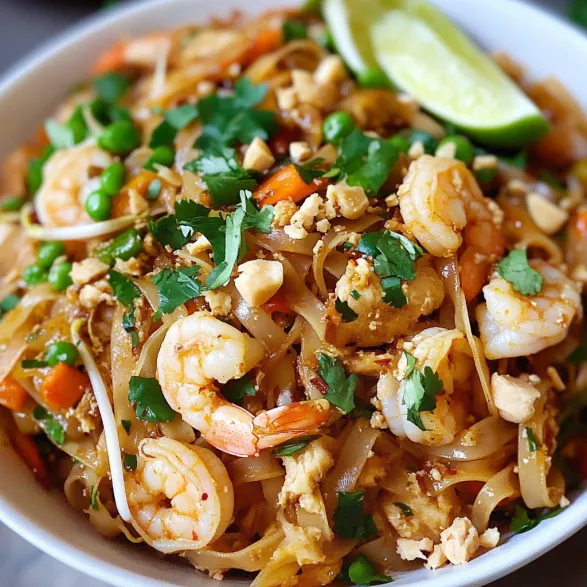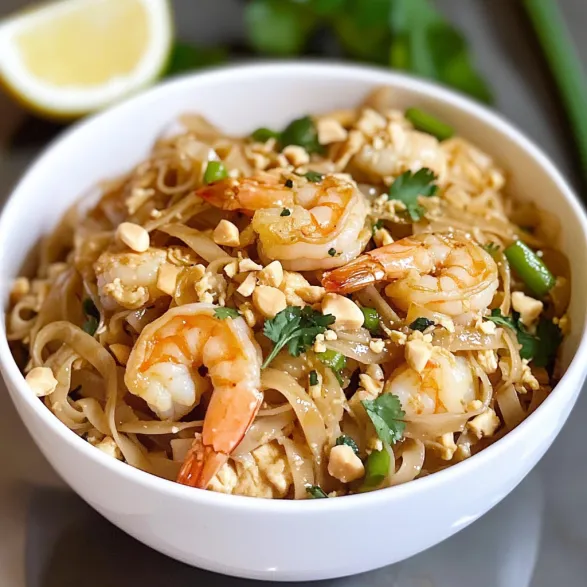 Save
Save
This flavorful homemade Pad Thai has become my go-to dinner when craving Thai cuisine without the delivery fees. The combination of succulent shrimp and tender chicken creates a protein-packed noodle dish that outshines restaurant versions with its perfect balance of tangy tamarind, gentle heat, and satisfying umami flavors.
I first made this Pad Thai during a dinner party where I wanted to impress my food-loving friends without spending hours in the kitchen. The empty plates and requests for seconds convinced me this recipe needed to become part of my regular rotation.
Ingredients
- Fish sauce: Provides that essential umami foundation traditional to Thai cuisine; look for bottles with only anchovy extract, water, and salt
- Tamarind paste: Delivers the signature tanginess authentic to real Pad Thai; found in Asian markets or online
- Rice noodles: The traditional base; choose medium width sticks for the proper texture and bite
- Fresh bean sprouts: Add essential crunch and lightness; always rinse thoroughly before using
- Roasted peanuts: Contribute crucial texture contrast and nutty depth; crush them just before serving
- Lime wedges: Brighten the entire dish with fresh acidity; never skip this finishing touch
Step-by-Step Instructions
- Noodle Preparation:
- Soak rice noodles in room temperature water for a full hour or warm water for 10 minutes until they become pliable but still firm in the center. This prevents them from becoming mushy during the final cooking stage. Drain thoroughly and set aside.
- Sauce Creation:
- Combine fish sauce, soy sauce, brown sugar, tamarind paste, and hot sauce in a small bowl, whisking until the sugar completely dissolves. The sauce should taste balanced between sweet, tangy, and savory, with noticeable heat. Adjust any component to your preference.
- Protein Cooking:
- Heat oil in a wok or large skillet until shimmering but not smoking. Add chopped garlic and stir quickly for 10 seconds before adding chicken pieces. Cook for 2 minutes, then add shrimp, continuing until proteins are nearly but not completely cooked through, about 2 more minutes.
- Egg Integration:
- Push all ingredients to one side, creating an empty space in the pan. Add a small drizzle of oil if needed, then crack an egg directly into this space. Let it sit undisturbed for 30 seconds as the whites begin to set, then begin scrambling and folding it into the protein mixture.
- Noodle Combination:
- Add the soaked and drained noodles to the pan along with bean sprouts, green onions, and your prepared sauce. Use tongs or two utensils to lift and fold everything together, ensuring even coating of the sauce. Season with a small pinch of salt and freshly cracked pepper.
- Final Cooking:
- Continue tossing everything over medium-high heat for 3 to 4 minutes. If the noodles seem too firm or the sauce too thick, add 1 to 2 tablespoons of water to create steam and help cook the noodles through completely. The finished noodles should be tender but still have slight resistance when bitten.
 Save
Save
Tamarind paste is truly the secret ingredient here. The first time I made this recipe I substituted lime juice, thinking it would work similarly. My Thai neighbor kindly corrected me, explaining that the specific complexity of tamarind cannot be replicated and brings the authentic character to proper Pad Thai.
Authentic Technique
Traditional Pad Thai is cooked quickly over very high heat, which creates those delicious caramelized edges on the noodles. Use the hottest setting your stove allows and work quickly. The entire cooking process after the noodles are soaked should take less than 10 minutes. This rapid cooking preserves the fresh texture of each ingredient while developing complex flavors.
Storage Tips
Pad Thai keeps remarkably well in the refrigerator for up to three days. Store in an airtight container, but keep garnishes separate. When reheating, add a tablespoon of water to prevent dryness and heat in a skillet rather than microwave to maintain textural integrity. The flavors often deepen overnight, making day two Pad Thai sometimes even more delicious than fresh.
Ingredient Substitutions
For gluten-free diners, ensure your soy sauce is certified gluten-free or substitute with tamari. If fish sauce is unavailable, you can create a substitute with anchovy paste and salt, though the flavor profile will be slightly different. Vegetarians can omit the chicken and shrimp, replacing with firm tofu and doubling the egg for protein. For a nut allergy, simply omit the peanuts and consider toasted sesame seeds as an alternative garnish.
 Save
Save
Common Recipe Questions
- → Can I substitute the tamarind paste in this Pad Thai?
Yes, if tamarind paste is unavailable, you can substitute with a mixture of 1 tablespoon lime juice and 1 tablespoon brown sugar. While it won't perfectly replicate the unique tanginess of tamarind, it will provide a similar sweet-sour balance to your dish. Rice vinegar with a touch of honey is another potential substitute.
- → How can I make this Pad Thai vegetarian?
To make a vegetarian version, replace the chicken and shrimp with extra-firm tofu (pressed and cubed) and add more vegetables like bell peppers and carrots. Substitute fish sauce with vegetarian fish sauce or a mixture of soy sauce and a little lime juice. Make sure to use a vegetarian hot sauce as well.
- → What type of noodles work best for Pad Thai?
Traditional flat rice noodles (sometimes labeled as 'Pad Thai noodles' or 'rice stick noodles') work best. Look for noodles that are about 1/4 inch wide. In a pinch, you can substitute with other rice noodle varieties, though the texture might differ slightly from authentic Pad Thai.
- → How do I prevent my Pad Thai noodles from clumping together?
To prevent clumping, don't overcook the rice noodles—they should be soaked just until pliable but still firm (al dente). After draining, rinse them under cold water and toss with a teaspoon of oil if you're not using them immediately. Also, add the noodles to the hot wok and keep them moving constantly to prevent sticking.
- → Can I make the Pad Thai sauce ahead of time?
Yes, the Pad Thai sauce can be made up to a week in advance and stored in an airtight container in the refrigerator. This is actually beneficial as it allows the flavors to meld together. Just give it a good stir before using as some ingredients may settle.
- → What should I serve with Chicken & Shrimp Pad Thai?
Pad Thai is typically served as a complete meal on its own, but you can pair it with Thai-inspired appetizers like spring rolls, satay skewers, or tom yum soup. A light cucumber salad also complements the rich flavors of Pad Thai nicely.
